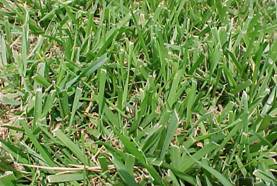Tall Fescue
General Information
Tall fescue is a cool-season perennial grass with very good tolerance to heat. Of all the cool-season grasses, tall fescue is the best adapted to Kansas conditions. While tall fescue grows and performs best on good, moist soils that are heavy to medium in texture, it exists and performs relatively well on soils that vary from strongly acid (pH 4.7) to alkaline (pH 9.5). It thrives and conserves soil on thin, droughty slopes, and forms dense sods on poorly drained soils where few other cool-season grasses survive. The massive root structure of tall fescue is generally credited for its adaptation to many varied soil types and its excellent tolerance to heat and drought.
Tall fescue has a bunch-type growth habit. Therefore, when utilized for turf, seeding rates and seed distribution must be carefully monitored. Six to 10 lbs. per 1,000 sq. feet are generally adequate to achieve uniform, dense stands of turf. Tall fescue may be planted in late summer/early fall or late winter/early spring. In Kansas, late summer/early fall planting dates are generally preferred as this allows the grass the luxury of two cool seasons in which to become established, prior to the onset of the hot and dry conditions associated with Kansas summers.
In recent years, much effort has been expended by grass breeders to improve tall fescue cultivars for turf applications. This effort has resulted in hundreds of new varieties being released. These new varieties are collectively termed “turf-type” tall fescue. In general, the new turf-type tall fescue varieties are finer-bladed and darker green in color when compared to the common or forage type tall fescues. Many of these new turf-types have a slower growth pattern and a greater propensity to tiller than the older varieties. This results in a denser, finer textured turf that is more tolerant to lower mowing heights.
When compared to other cool-season grass species utilized for turf in Kansas, tall fescue has better heat tolerance, requires less nitrogen and irrigation and has fewer disease problems. It is the only grass that will remain green year around as long as there is adequate soil moisture to keep it actively growing.
KY31
KY31 tall fescue is an older variety that has enjoyed tremendous popularity both as a forage and turf product. With the advent of the turf type tall fescues, KY31 usage has declined in the home owner market. The newer turf-types are darker green in color and provide a denser and finer textured turf. However, KY31 tall fescue continues to be a favorite of the price conscious consumer and is a superior product for use in low maintenance applications, such as highway plantings, industrial parks, and city or school athletic fields.
KY31 is particularly well adapted to areas where the soil may be thin and poor. It tolerates acid or alkaline soils and performs well on dry or poorly drained soils. It requires little fertilization and provides an attractive lawn under almost all types of growing conditions. KY31 is highly durable due to an extensive, deep root system. When the grass takes a beating, life-giving roots help it spring back for more. This feature makes KY31 ideal for heavy-traffic or recreation areas. The extensive root system of KY31 can also be credited with providing excellent drought tolerance.
KY31 is perhaps the most environment friendly cool-season turf grass available to Kansas consumers. It requires little in the way of irrigation or fertility and is one of the most disease and insect resistant grasses available. The dense root system chokes out weeds and prevents them from sprouting. You will spend little or no time applying weed killers and pesticides. For example, Brown Patch is one of the most serious disease problems of tall fescue lawns. KY31 exhibits better resistance to Brown Patch than most of the new turf-types.
Planting Recommendations
Use a power rake or roto-tiller to loosen the soil surface
Fertilizing: Apply a good non-burning fertilizer according to manufacturer’s instructions and mix it into the top layer of soil. (A soil test is the most reliable method of determining fertilizer needs)
Sowing: Best results are generally obtained with early fall or early spring planting dates
To establish new lawns-apply at the rate of 8 to 10 pounds per 1000 square feet
To over-seed an existing lawn-apply seed at the rate of 10 to 12 pounds per 1000 square feet
For even coverage, divide the required seed into two equal parts-sowing the first half in one direction and the second half at right angles.Watering: Keep surface soil moist by frequent watering with a fine spray until germination is accomplished (approximately 2 weeks). Heavier less frequent watering is sufficient as seedlings grow to mowing height
Mowing: When the new grass reaches three inches in height, use a sharp mower to cut it to a height of two and a half inches. Maintain a two and a half to three inch height year-round to help the grass retain water during dry periods and shade out weeds before they establish.
TLC
Information coming.
Titan Rx
Information coming.

